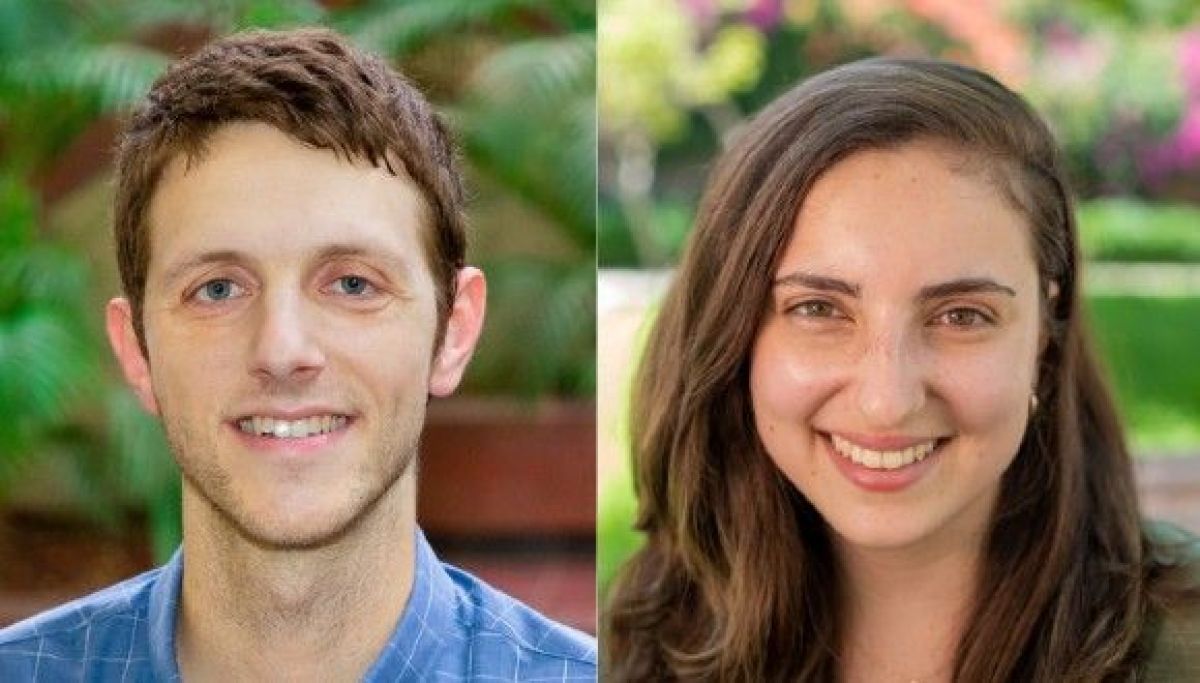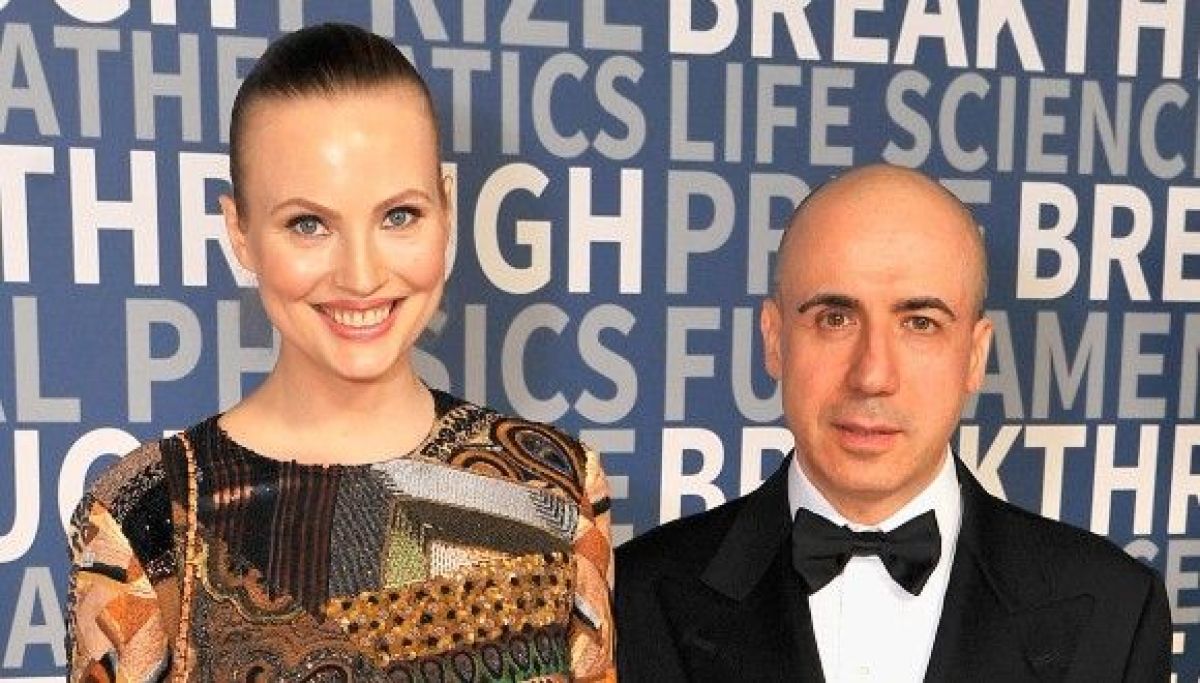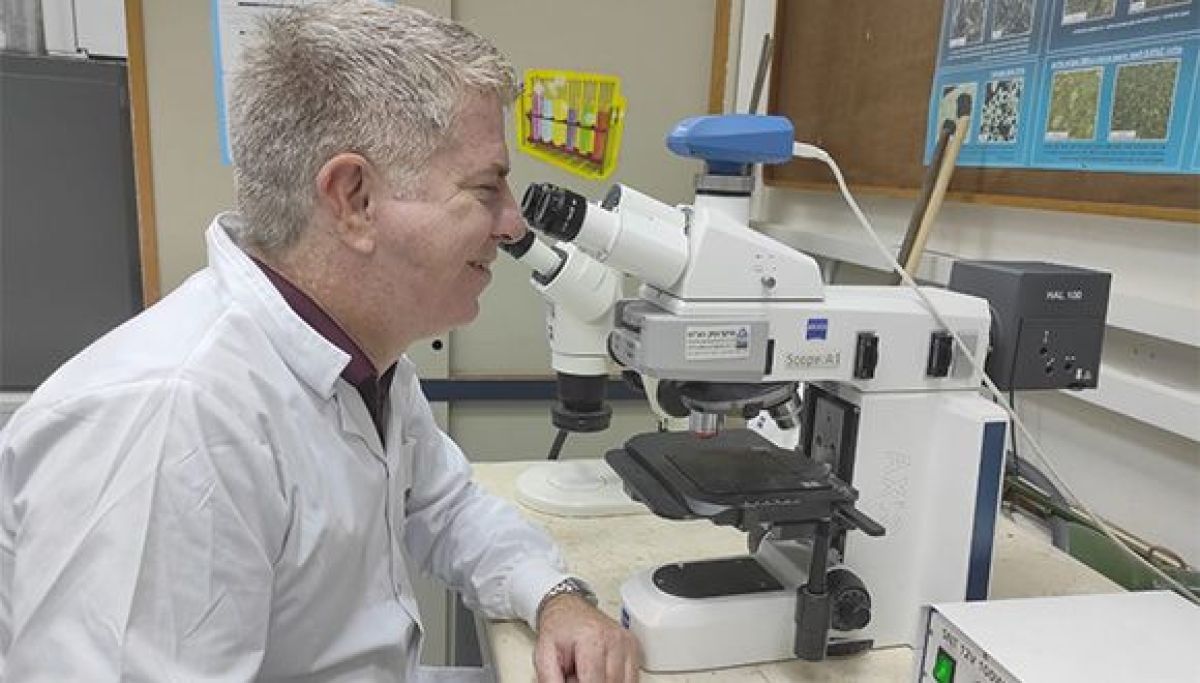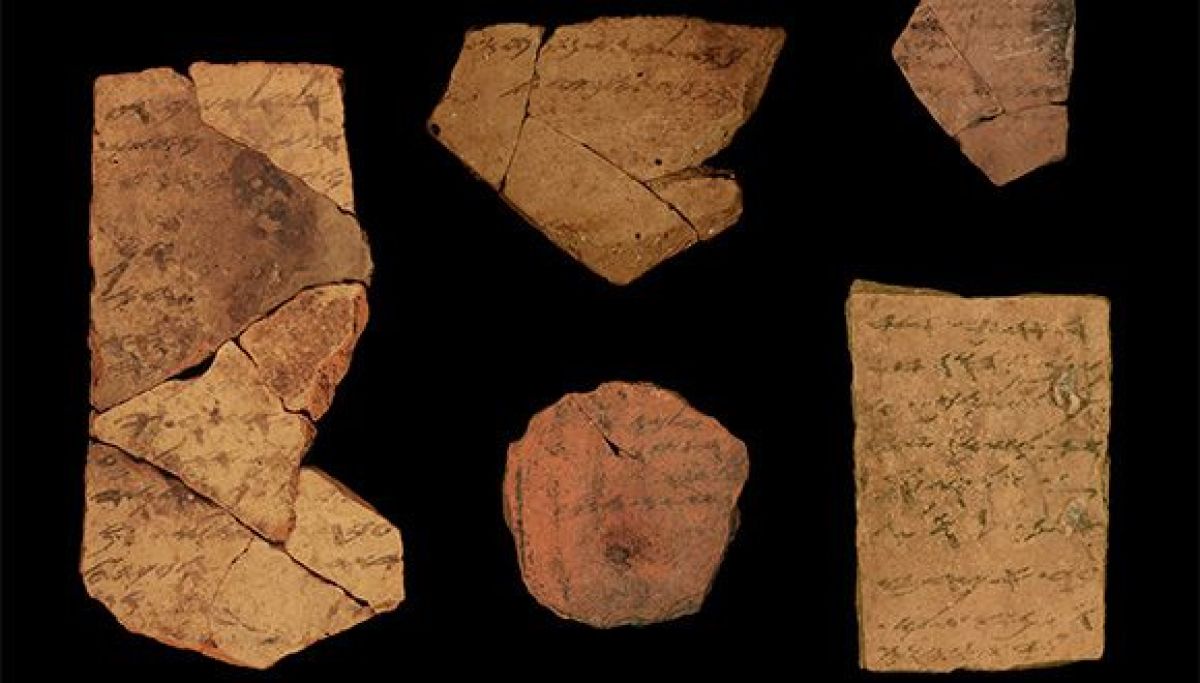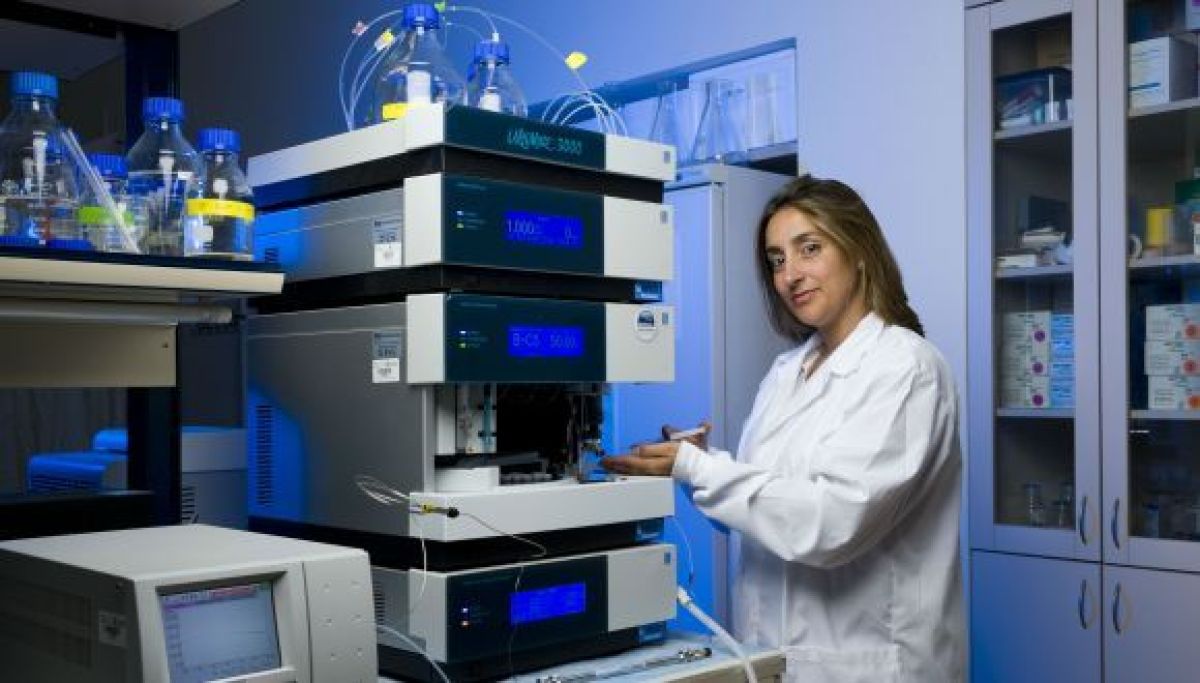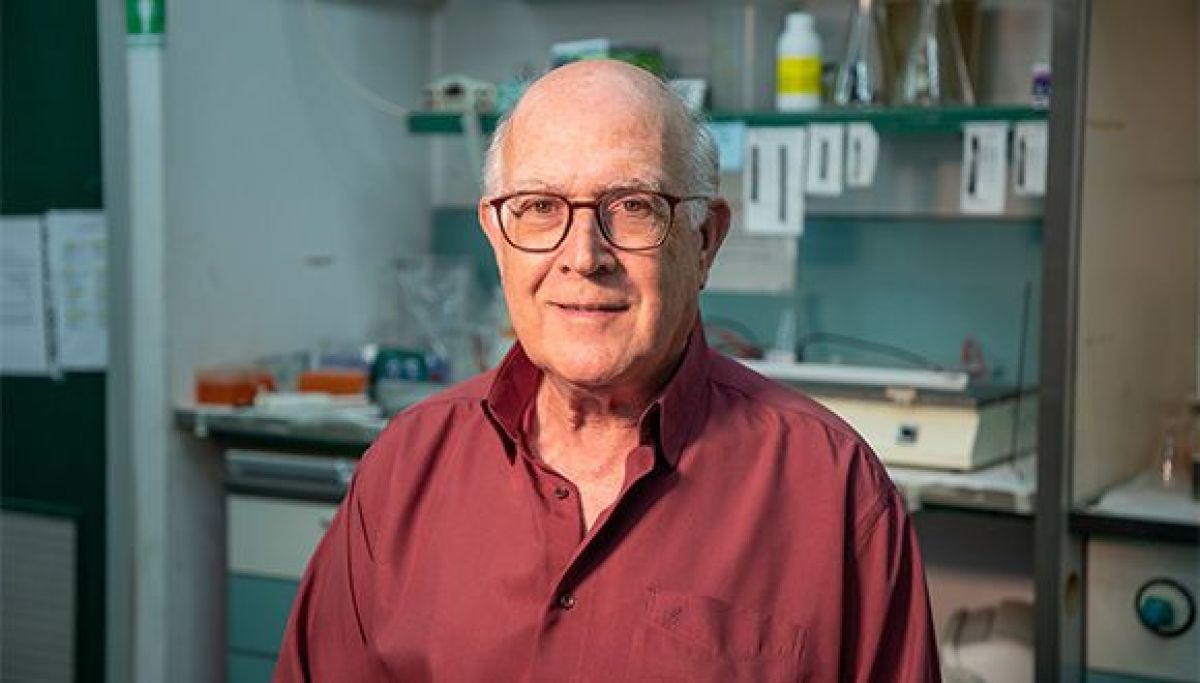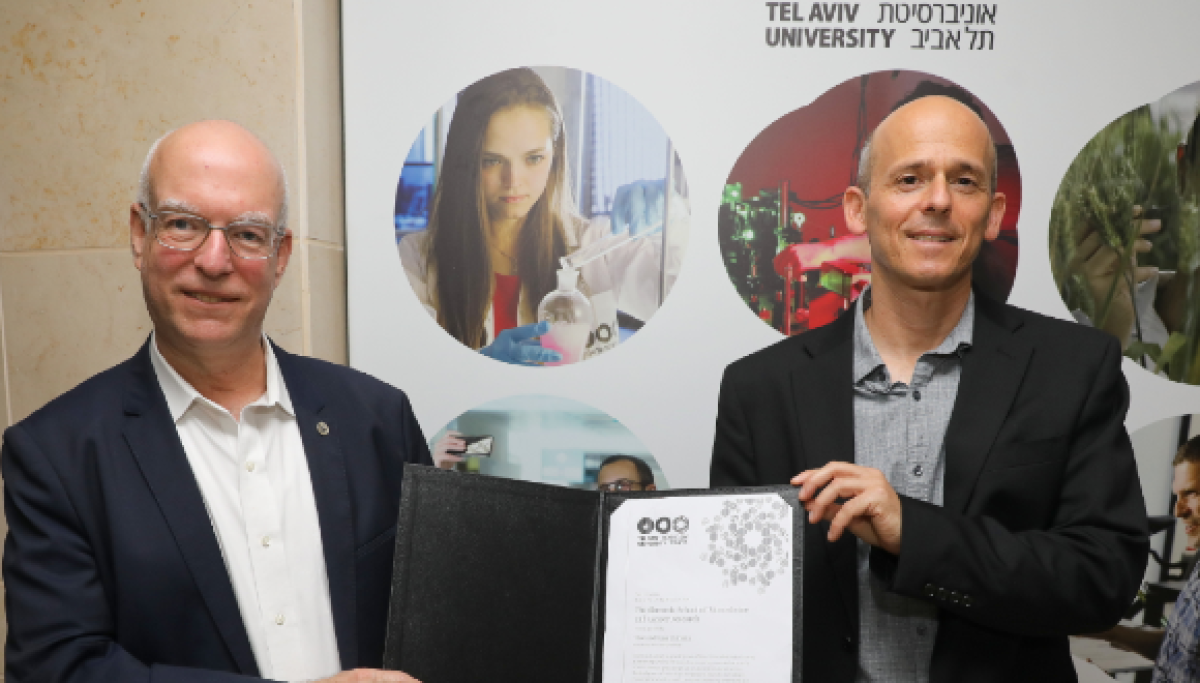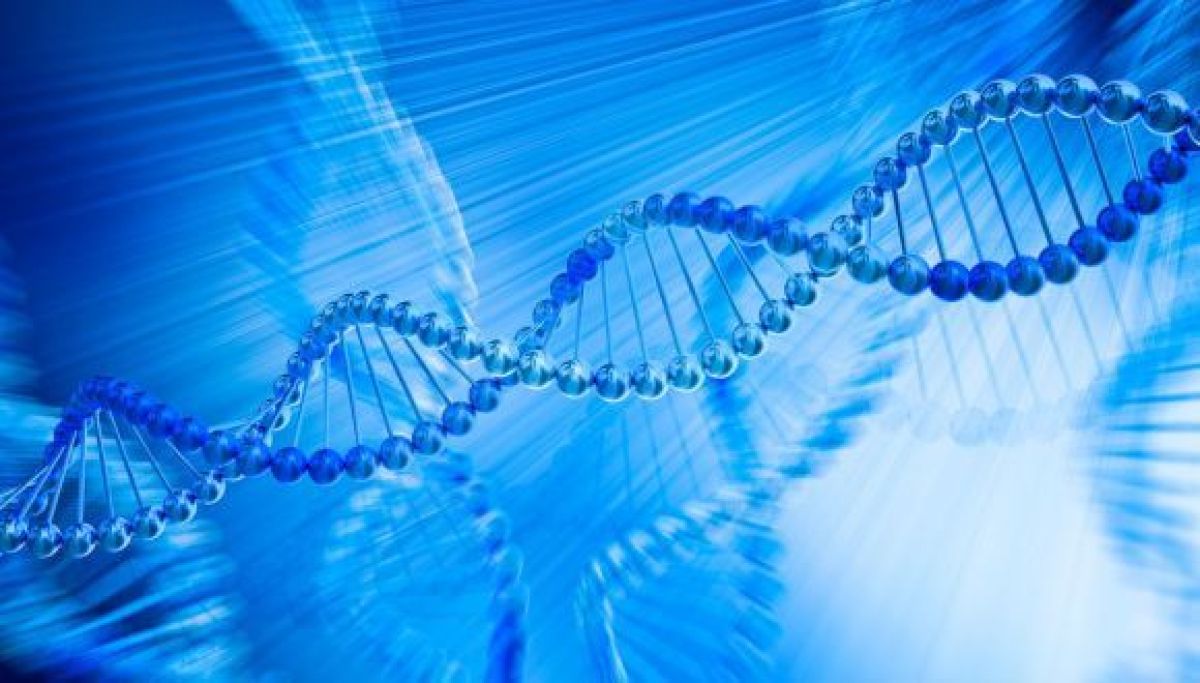Author: AUFTAU
“A Scientific Discovery Can Never Be Undone”
 We must also recognize that science is global and universal. It is one of the few fabrics that connects the world and brings us all together. Especially in the world now, when people are feeling separated from each other due to the COVID-19 crisis, I think science is one of those elements that brings us all together.
Photo (left): The Milners at a TAU event in honor of the 70 for 70 Initiative. Credit: Yehonatan Zur.
What lies behind your idea that scientists should be compensated like celebrities?
In today’s world, recognition is based on either celebrity status or financial wealth. Few people are celebrated for their intellectual achievements. What the Breakthrough Prize is trying to achieve is to bring about a more balanced world whereby intellectual achievement will be celebrated at least on par with other achievements, and where scientists will receive the recognition they deserve. We thought that celebrating the most brilliant minds could maybe inspire kids interested in science to pursue an academic career.
What advice would you give to young Israeli scientists who dream of changing the world?
Although I tried for a number of years to do this myself, I wasn’t too successful. My advice would be contrary to my own experience – try to focus on fundamental science. If you put your name on a building, that building will not survive over hundreds of years. But if you make a scientific discovery, this is something that cannot ever be undone. In a thousand years from now, Einstein will still be remembered for his theory of general relativity, while many other great men will be forgotten. So if you really want to leave a lasting legacy for our civilization, the only sure way is through fundamental science and making discoveries.
I envy people who choose basic science as their occupation. Not being able to make a contribution myself, I am trying to focus our foundation on supporting those who can.
Tell us about your connection to Israel and making Aliyah.
I became an Israeli citizen over 20 years ago. This was really an important calling for me because, growing up in the Soviet Union, I had limited ability to connect with my heritage and ancestors in a meaningful way. As soon as it was possible, I decided to become an Israeli citizen and, to the extent possible, to contribute to the State of Israel.
Featured image: Yuri and Julia Milner. Courtesy of Yuri and Julia Milner.
We must also recognize that science is global and universal. It is one of the few fabrics that connects the world and brings us all together. Especially in the world now, when people are feeling separated from each other due to the COVID-19 crisis, I think science is one of those elements that brings us all together.
Photo (left): The Milners at a TAU event in honor of the 70 for 70 Initiative. Credit: Yehonatan Zur.
What lies behind your idea that scientists should be compensated like celebrities?
In today’s world, recognition is based on either celebrity status or financial wealth. Few people are celebrated for their intellectual achievements. What the Breakthrough Prize is trying to achieve is to bring about a more balanced world whereby intellectual achievement will be celebrated at least on par with other achievements, and where scientists will receive the recognition they deserve. We thought that celebrating the most brilliant minds could maybe inspire kids interested in science to pursue an academic career.
What advice would you give to young Israeli scientists who dream of changing the world?
Although I tried for a number of years to do this myself, I wasn’t too successful. My advice would be contrary to my own experience – try to focus on fundamental science. If you put your name on a building, that building will not survive over hundreds of years. But if you make a scientific discovery, this is something that cannot ever be undone. In a thousand years from now, Einstein will still be remembered for his theory of general relativity, while many other great men will be forgotten. So if you really want to leave a lasting legacy for our civilization, the only sure way is through fundamental science and making discoveries.
I envy people who choose basic science as their occupation. Not being able to make a contribution myself, I am trying to focus our foundation on supporting those who can.
Tell us about your connection to Israel and making Aliyah.
I became an Israeli citizen over 20 years ago. This was really an important calling for me because, growing up in the Soviet Union, I had limited ability to connect with my heritage and ancestors in a meaningful way. As soon as it was possible, I decided to become an Israeli citizen and, to the extent possible, to contribute to the State of Israel.
Featured image: Yuri and Julia Milner. Courtesy of Yuri and Julia Milner.
TAU Professor First Israeli Named to US Inventors’ Academy
Noam Eliaz is a global change-maker in materials engineering
In a significant first for Israeli academia, TAU’s Prof. Noam Eliaz has been selected as a senior member of the National Academy of Inventors, USA.
Eliaz, of the Fleischman Faculty of Engineering, founded its Department of Material Science and Engineering and is the director of the Biomaterials and Corrosion Laboratory.
“As inventors and entrepreneurs our job is to constantly look for the next professional challenge and develop the new groundbreaking invention, for the benefit of society and technology,” said Eliaz. “This is the first time that an Israeli has been elected as a senior member of the academy, and I hope that this will open the door for more Israeli researchers to integrate as senior members in the future.”
Eliaz’s research is multidisciplinary and touches on both basic and applied sciences. He is considered a global leader in several disciplines which have direct applications to the defense and implant industries. He previously served as a metallurgical laboratory officer in the Israeli Air force, and was a Fulbright and Rothschild postdoctoral scholar at MIT.
Eliaz is one of 38 new senior members whom the Academy recently recognized for groundbreaking achievements in the development of patents and technologies that impact the welfare of society and contribute to the innovation ecosystem.
Prof. Noam Eliaz
Google Awards Competitive Grant to Tel Aviv University for COVID-19 Research
The grant is for high-impact research using Data Science and Artificial Intelligence (AI) to combat the coronavirus
Google.org, a Google fund aimed at supporting data based solutions for some of humanity’s greatest challenges, chose to award a competitive grant to Tel Aviv University for high-impact research employing Data Science and Artificial Intelligence (AI) to combat COVID-19. This step is one of many taken by Google in its ongoing effort to contribute to the global battle against the pandemic while also promoting its “AI for Social Good” research program – headed by, among others, Prof. Yossi Matias, Vice President at Google and CEO of the Research and Development Center at Google Israel. The Israeli center is a key player in Google’s endeavors to combat COVID-19, and also to help protect populations faced with natural disasters such as floods, earthquakes and wildfires.
The grant is being awarded to TAU’s AI and Data Science Center for research employing AI techniques and advanced statistical methods to improve COVID-19 public health measures. Using data from government ministries (Health, Transport, etc.) and the Israel Central Bureau of Statistics, the researchers intend to build an accurate high-resolution model of the spread of the pandemic and then use it to plan and test various methods for stopping infection. This interdisciplinary research brings together TAU scientists from the Porter School of the Environment and Earth Sciences, the School of Public Health, the Department of Statistics and Operations Research, the Blavatnik School of Computer Science, the School of Electrical Engineering, and the Gertner Institute for Epidemiology and Health Policy Research.
Prof. Meir Feder, Head of the AI and Data Science Center at Tel Aviv University: “We’re proud that Google has chosen to award this significant grant to our center in order to expand COVID-19 research in Israel. This grant will support the development of AI and Reinforcement Learning based tools for planning and examining the effects of different steps on the spread of the pandemic. The research findings will be used by decision-makers in their efforts to establish policies for stopping the pandemic.”
Featured image: Prof. Meir Feder, Head of the AI and Data Science Center at Tel Aviv University
The Texts From The Biblical-Period Fortress At Tel Arad Were Written By 12 Different Authors
The implication: Literacy in the kingdom of Judah was widespread
Who wrote the books of Deuteronomy, Joshua, Judges, Samuel and Kings?
The special interdisciplinary study was conducted by Dr. Arie Shaus, Ms. Shira Faigenbaum-Golovin, and Dr. Barak Sober of the Department of Applied Mathematics, Prof. Eli Piasetzky of the Raymond and Beverly Sackler School of Physics and Astronomy, and Prof. Israel Finkelstein of the Jacob M. Alkow Department of Archeology and Ancient Near Eastern Civilizations. The forensic handwriting specialist is Ms. Yana Gerber, a senior expert who served for 27 years in the Questioned Documents Laboratory of Israel Police Division of Identification and Forensic Science, and in the police’s International Crime Investigations Unit. “There is a lively debate among experts as to whether the books of Deuteronomy, Joshua, Judges, Samuel and Kings were compiled in the last days of the kingdom of Judah, or after the destruction of the First Temple by the Babylonians,” explains Dr. Shaus. “One way to try to get to the bottom of this question is to ask when there was the potential for the writing of such complex historical works. For the period following the destruction of the First Temple in 586 BC, there is a very scant archaeological evidence of Hebrew writing in Jerusalem and its surroundings, whereas for the period preceding the destruction of the Temple, an abundance of written documents has been found. But then the question arises – who wrote these documents? Was this a society with widespread literacy, or was there just a handful of literate people?” To answer this question, the researchers examined the writings found in Tel Arad – ostraca (fragments of pottery vessels containing ink inscriptions) that were discovered at the Tel Arad site in the 1960s. Tel Arad was a small military post on the southern border of the kingdom of Judah; its built-up area was about two dunams and it housed between 20 and 30 soldiers. “We examined the question of literacy empirically, from different directions of image processing and machine learning,” says Ms. Faigenbaum-Golovin. “Among other things, these areas help us today with the identification, recognition and analysis of handwriting, signatures, and so on. The big challenge was to adapt modern technologies to 2,600-year-old ostraca. With a lot of effort, we were able to produce two algorithms that could compare letters and answer the question of whether two given ostraca were written by two different people.”Police detective work following biblical texts
In 2016, the researchers published in Proceedings of the National Academy of Sciences of the United States of America (PNAS) that algorithmically, and with high statistical probability, 18 texts – the longest of the Tel Arad inscriptions – were written by at least four different authors. Combined with the textual evidence, the researchers concluded that there were in fact at least six different writers. The study aroused great interest around the world. Now, in an unprecedent move, the Tel Aviv University researchers have decided to compare the algorithmic methods, which have since been refined, to the forensic approach. To this end, Yana Gerber, a retired superintendent and senior questioned document examiner from the Israel Police Division of Identification and Forensic Science, joined the team. After an in-depth examination of the ancient inscriptions, Ms. Gerber found that the 18 texts were written by at least 12 distinct writers with varying degrees of certainty. Gerber examined the original Tel Arad ostraca at the Israel Museum, the Eretz Israel Museum, the Sonia and Marco Nedler Institute of Archaeology of Tel Aviv University, and the Israel Antiquities Authority’s warehouses at Beit Shemesh. “This study was very exciting, perhaps the most exciting in my professional career,” says Ms. Gerber. “These are ancient Hebrew inscriptions written in ink on shards of pottery, utilizing an alphabet that was previously unfamiliar to me. I studied the characteristics of the writing in order to analyze and compare the inscriptions, while benefitting from the skills and knowledge I acquired during my bachelor’s degree in classical archaeology and ancient Greek at Tel Aviv University. I delved into the microscopic details of these inscriptions written by people from the First Temple period, from routine issues such as orders concerning the movement of soldiers and the supply of wine, oil and flour, through correspondence with neighboring fortresses, to orders that reached the Tel Arad fortress from the high ranks of the Judahite military system. I had the feeling that the time stood still and there was no gap of 2,600 years between the writers of the ostraca and ourselves.”Combining forces between the human eye and the algorithm
Gerber explains: “Handwriting is made up of unconscious habit patterns. The handwriting identification is based on the principle that these writing patterns are unique to each person and no two people write exactly alike. It is also assumed that repetitions of the same text or characters by the same writer are not exactly identical and one can define a range of natural handwriting variations specific to each one. Thus, the forensic handwriting analysis aims at tracking features corresponding to specific individuals, and concluding whether a single or rather different authors wrote the given documents. The examination process is divided into three steps: analysis, comparison, and evaluation. The analysis includes a detailed examination of every single inscription, according various features, such as the spacing between letters, their proportions, slant, etc. The comparison is based upon the aforementioned features across various handwritings. In addition, consistent patterns, common for different inscriptions, are identified i.e., the same combinations of letters, words, punctuation, etc. Finally, an evaluation of identicalness or distinctiveness of the writers is made. It should be noted that according to an Israel Supreme Court ruling, a person can be convicted of a crime based on the opinion of a forensic handwriting expert.” Says Dr. Shaus: “We were in for a big surprise: Yana identified more authors than our algorithms did. It must be understood that currently, our algorithms are of a “cautious” nature – they know how to identify cases in which the texts were written by people with significantly different writing; in other cases they refrain from definite conclusions. Contrastingly, an expert in handwriting analysis knows not only how to spot the differences between writers more accurately, but in some cases may also arrive at the conclusion that several texts were actually written by a single person. Naturally, in terms of consequences, it is very interesting to see who the authors are. Thanks to the findings, we were able to construct an entire flowchart of the correspondence concerning the military fortress – who wrote to whom and regarding what matter”. This reflects the chain of command within the Judahite army. “For example, in the area of Arad, close to the border between the kingdoms of Judah and Edom, there was a military force whose soldiers are referred to as “Kittiyim” in the inscriptions, most likely Greek mercenaries. Someone, probably their Judahite commander or liaison officer, requested provisions for the Kittiyim unit. He writes to the quartermaster of the fortress in Arad ‘give the Kittiyim flour, bread, wine’ and so on. Now, thanks to the identification of the handwriting, we can say with high probability that there was not only one Judahite commander writing, but at least four different ones. It is conceivable that each time another officer was sent to join the patrol – they took turns.”Literary education in the Kingdom of Judah
According to the researchers, the findings shed new light on Judahite society on the eve of the destruction of the First Temple – and on the setting of the compilation of biblical texts. “It should be remembered that this was a small outpost, one of a series of outposts on the southern border of the kingdom of Judah,” says Dr. Sober. “Since we found at least 12 different authors out of 18 texts in total, we can conclude that there was a high level of literacy throughout the entire kingdom. The commanding ranks and liaison officers at the outpost, and even the quartermaster Eliashib and his deputy, Nahum, were literate. Someone had to teach them how to read and write, so we must assume the existence of an appropriate educational system in Judah at the end of the First Temple period. This, of course, does not mean that there was almost universal literacy as there is today, but it seems that significant portions of the residents of the kingdom of Judah were literate. This is important to the discussion on the composition of biblical texts. If there were only two or three people in the whole kingdom who could read and write, then it is unlikely that complex texts would have been composed.” “Whoever wrote the biblical works did not do so for us, so that we could read them after 2,600 years, they did so in order to promote the ideological messages of the time,” Prof. Finkelstein says. “There are different opinions regarding the date of the composition of biblical texts. Some scholars suggest that many of the historical texts in the Bible – from Joshua to II Kings – were written at the end of the 7th century BC, that is, very close to the period of the Arad ostraca. It is important to ask who these texts were written for. According to one view, there were events in which the few people who could read and write stood before the illiterate public and read texts out to them. A high literacy rate in Judah puts things into a different light.” Prof. Finkelstein adds: “Until now, the discussion of literacy in the kingdom of Judah has been based on circular arguments, that is, on what is written within the Bible itself, for example on scribes in the kingdom. We have shifted the discussion to an empirical perspective. If in a remote place like Tel Arad there was, over a short period of time, a minimum of 12 authors of 18 inscriptions, out of the population of Judah which is estimated to have been no more than 120,000 people, it means that literacy was not the exclusive domain of a handful of royal scribes in Jerusalem. The quartermaster from the Tel Arad outpost also had the ability to read and appreciate them.” Featured image: Hebrew ostraca from AradTAU Joint Study: COVID-19 Deaths Dive on Weekends
TAU Economics Prof. Neil Gandal and his brother of CCNY find one city that defies trend: New York City
Tel Aviv University’s Prof. Neil Gandal from Berglas School of Economics, together with his brother Prof. Keith Gandal from City College of New York, examined U.S. COVID-19 deaths by day of the week. Mysteriously, the same pattern has repeated every single week of the pandemic: deaths rise from Tuesday-Friday and come down Saturday-Monday, hitting a nadir on Sunday or Monday. Controlling for time trends, deaths during weekends were at least 40 percent lower than on weekdays.
According to the researchers, the average death toll from COVID-19 in the U.S. has been 901 deaths on Saturdays, 682 on Sundays, and 699 on Mondays. The Sunday-Monday average then sharply rises on Tuesdays to 1,119. Wednesdays are the worst in terms of COVID-19, with an average of 1,130 deaths – nearly 95 percent higher than your average Sunday and almost 90 percent higher than your average Monday. Then, on Thursdays, the daily average begins to go down again with 1,128 deaths, followed by 1,033 deaths on Fridays.
This weekend effect does not occur in New York City. Without New York City, deaths during the Tuesday to Friday period in the U.S. are 50 percent higher than the Saturday to Monday period.
The same effect was found in COVID-19 mortality rates for the rest of the world – though much weaker; there is a 20 percent less chance of dying from the disease on weekends than on weekdays globally. Historical research shows that such a weekend effect exists for overall deaths, but it is weaker than with COVID-19. In the case of England, for example, researchers found that for every 100 deaths among patients in a hospital on Wednesday, there are 92 deaths among similar patients in the hospital on a Sunday.
“The robustness analyses we did, and the fact that the weekend effect does not exist in NYC, suggest that our results are not likely due just to reporting issues,” says Prof. Neil Gandal. “It seems to us probable that something social or cultural is going on with overall U.S. COVID-19 deaths, corresponding to differing behaviors and attitudes tied to different parts of the week. Perhaps people tend to relax more on the weekends, even in hospitals or long-term care facilities. Meanwhile, in NYC, my brother Keith tells me, the familiar rhythms of the American week were simply wiped away between mid-March and the end of May. During that period, every day seemed the same, as in the movie ‘Groundhog Day.’ Except it was Coronavirus Day. Each day, you woke up to disbelief, dread, even horror, and soon enough, you heard the wail of ambulances. All day long, no one was on the streets. Even Times Square was empty. The sirens didn’t stop at night. Could worrying, watching the frightening news coverage of the pandemic, and ultimately panicking about COVID-19, be increasing the death toll? We leave this for future research.”
Targeting Melanoma
TAU researchers create a nanocarrier that selectively delivers two medications and releases them simultaneously at the malignant target
Researchers at Tel Aviv University, led by Prof. Ronit Satchi-Fainaro from the Department of Physiology and Pharmacology at the Sackler Faculty of Medicine, developed an innovative nanotechnological drug delivery system that significantly enhances the effectiveness of treatment for the aggressive skin cancer melanoma. The nanocarrier is a biocompatible and biodegradable polymer, which comprises repeating units of glutamic acids (PGA- polyglutamic acid), packaging together two biological drugs belonging to different families with proven efficacy for the treatment of melanoma: BRAF inhibitors (Dabrafenib) and MEK inhibitors (Selumetinib, approved for use in children with NF1 – neurofibromatosis type I).
Prof. Satchi-Fainaro: “One of the major obstacles of the biological treatments is that after a while, the cancer cells develop resistance to the drugs. We assume that by precise delivery of two or more targeted drugs that will attack the cancer cells forcefully and simultaneously from different directions, we can delay or even prevent the acquisition of this drug-resistance.”
The research group included PhD students Evgeni Pisarevsky, Dr. Rachel Blau and Yana Epshtein from Prof. Satchi-Fainaro’s research laboratory at TAU’s Sackler School of Medicine. The paper was published as the cover article of the August 2020 issue of Advanced Therapeutics.
Prof. Satchi-Fainaro: “In this project, we looked for a solution to a problem often associated with drug cocktails: Today, most oncological treatments are administered in the form of cocktails of several medications; However, despite the fact that all drugs are administered to the patient simultaneously, they do not reach the tumor at the same time, due to differences in basic parameters – like how long they survive in the bloodstream (i.e. half-life), and the time it takes each drug to reach the tumor tissue. Thus, in most cases, the medications do not work concurrently, which prevents them from attaining optimal synergistic activity.”
Responding to these challenges, the researchers developed an innovative, efficient and biodegradable drug delivery system. Two biological drugs, known to be effective for the treatment of melanoma, Dabrafenib and Selumetinib, (inhibiting two different components – BRAF and MEK respectively – in the biological pathway which is over-activated in melanoma), were chosen, with the intention of delivering them jointly to the tumor by using a nanocarrier. The drug nanocarrier chosen for the task was PGA, a polymer of glutamic acid – one of nature’s most common amino acids. Developed in Prof. Satchi-Fainaro’s lab several years ago, the nanocarrier has already been tested successfully for treating pancreatic, breast and ovarian cancer in animal models.
In search of an optimal ratio
First, the researchers determined the optimal ratio between the two medications – based on levels and types of toxicity, as well as the resistance mechanism developed by cancer cells for each medication – to ultimately ensure maximum effectiveness, minimal toxicity and optimal synergistic activity. Another important advantage of joint delivery is reduced dosage: a much lower dose is required compared to each drug when administered independently.
The next step was using chemical modifications to enable bonding between the polymeric carrier and the chosen drugs. This combined system can travel through the body with total safety, inflicting no damage to healthy tissues. Upon reaching the cancer cells, the nanocarrier encounters proteins of the cathepsins enzyme family, which are highly activated in malignant tumors. The proteins degrade the polymer, releasing the drugs which become active and join forces to attack the tumor. Prof. Satchi-Fainaro: “It’s like several passengers riding in one cab and getting off together at the same address. They all arrive at the same destination, right at the same time.”
Promising results
Tested on a mouse model of melanoma, the new treatment showed promising results: The nanocarrier delivered the two drugs to the tumor and released them there simultaneously in quantities about 20 times greater than those that reach the tumor when similar doses of the same medications are administered independently. In addition, the therapeutic effect achieved by the drugs delivered by the nanocarrier lasted much longer – 2-2.5 times compared to control group and the group treated with free medications. According to the researchers, this means that the new platform enables much lower dosages – about one third of the dose required in regular drug cocktails, and the treatment as a whole is both safer and more effective. Also, if needed, the new approach allows for dosages that are much higher than the maximum dosage permissible in current methods, thereby enhancing the effectiveness of the treatment even further.
Prof. Satchi-Fainaro: “In this project, we developed an innovative drug delivery system for treating melanoma, delivering two proven medications and releasing them simultaneously at the tumor site. The treatment proved both safer and more effective than the same medications administered as a cocktail. Moreover, our new platform is highly modular and can be used for delivering a vast range of medications. We believe that its potential for enhancing therapeutics for different diseases is practically endless.”
The study was funded by the Israel Cancer Research Fund (ICRF), the European Research Council (ERC), Israel’s Ministry of Health (EuroNanoMed-II program), the Melanoma Research Alliance, the Morris Kahn 3D BioPrinting for Cancer Research Initiative and the Israel Science Foundation (ISF).
Featured image: Prof. Ronit Satchi-Fainaro
TAU Wins 3M Grant to Accelerate COVID-19 Vaccine Development
Grantee Professor Jonathan Gershoni aims to block the coronavirus by targeting its most vulnerable spot
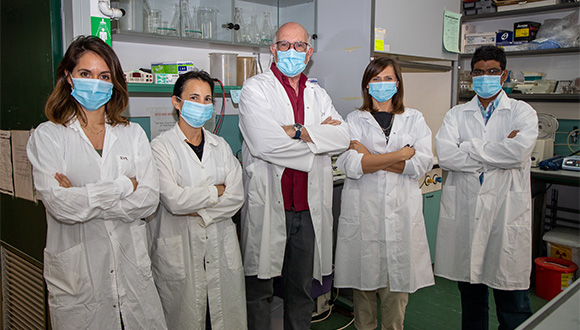 Prof. Gershoni’s Lab team (Photographer: Moshe Bedarshi)
This study is anchored in more than 30 years of research on the interaction of RNA viruses with their receptors and the immune response against them, noted Professor Tal Pupko, Head of the Shmunis School at TAU. “The 3M grant will dramatically accelerate the pace of research for overcoming COVID-19,” said Professor Pupko, adding that Tel Aviv University was particularly proud to be included in this important global initiative by 3M.
“Science is at the heart of 3M and we are committed to advancing the rapid study of this virus as part of our continued effort to combat the COVID-19 pandemic,” said Isabelle Zadikov-Carp, 3M Israel Country Leader. “It’s important that 3M holds true to its core values by supporting our communities and improving lives. We hope that the grant to TAU will facilitate the development of an effective vaccine and we will be keenly following the progress and outcomes of Professor Gershoni’s research with interest.”
Featured image: Professor Jonathan Gershoni (Photographer: Moshe Bedarshi)
Prof. Gershoni’s Lab team (Photographer: Moshe Bedarshi)
This study is anchored in more than 30 years of research on the interaction of RNA viruses with their receptors and the immune response against them, noted Professor Tal Pupko, Head of the Shmunis School at TAU. “The 3M grant will dramatically accelerate the pace of research for overcoming COVID-19,” said Professor Pupko, adding that Tel Aviv University was particularly proud to be included in this important global initiative by 3M.
“Science is at the heart of 3M and we are committed to advancing the rapid study of this virus as part of our continued effort to combat the COVID-19 pandemic,” said Isabelle Zadikov-Carp, 3M Israel Country Leader. “It’s important that 3M holds true to its core values by supporting our communities and improving lives. We hope that the grant to TAU will facilitate the development of an effective vaccine and we will be keenly following the progress and outcomes of Professor Gershoni’s research with interest.”
Featured image: Professor Jonathan Gershoni (Photographer: Moshe Bedarshi)
TAU Inaugurates Shmunis School of Biomedicine and Cancer Research
Recent Shmunis School achievements:
- The Gershoni Lab was awarded a US patent for a novel vaccine against the coronavirus
- The Stern Lab‘s genetic sequencing of the coronavirus tracked the spread of COVID-19 in Israel
- The Ehrlic Lab is developing virus-based immunotherapies for cancer
- The Lederkremer Lab developed a therapeutic approach for Huntington’s disease, for which no treatment exists
How the parents’ environment impacts the lives of their offspring
Three rules that dictate transgenerational epigenetic inheritance in worms – independently of changes in DNA sequences.
Researchers at Tel Aviv University have discovered three rules that dictate epigenetic inheritance – meaning transgenerational inheritance through means other than changes in DNA sequences. Published today in the leading scientific journal Cell, the study was led by Prof. Oded Rechavi and his research student Dr. Leah Houri-Zeevi of the Department of Neurobiology at the Faculty of Life Sciences and the Sagol School of Neuroscience at Tel Aviv University.
Most experiences we acquire in our lifetime will not be passed on to our descendants. For example, our workout in the gym today will not make our children stronger. However, studies conducted in recent years on epigenetic inheritance in worms challenge our traditional concepts regarding the limits of inheritance and evolution, indicating that some acquired traits are in fact passed on to subsequent generations. Prof. Rechavi explains: “Epigenetic inheritance of responses to the environment occurs independently of changes to the DNA sequence, through other inherited molecules. In many organisms, responses to environmental changes, such as stress, involve small RNA molecules that silence or block the expression of certain genes.” In recent years, research on C. elegans worms – an important and widely used model animal – has shown that small RNA molecules can be transmitted to subsequent generations, thereby passing on certain traits.
In previous research projects, Prof. Rechavi discovered that worms transfer to their offspring small RNA molecules containing information on the parent’s environment, such as viral infections, nutrition, and even brain activity, thereby contributing to the survival of subsequent generations. In the current study, Prof. Rechavi and his team tried to understand whether transgenerational epigenetic inheritance via small RNA molecules is governed by specific rules, or alternately, occurs passively and randomly.
According to Prof. Rechavi, “C. elegans is the preferred model organism for research on transgenerational epigenetic inheritance, for several reasons: Its generation time is three and a half days, allowing us to study many generations in a short period of time; every worm produces hundreds of descendants, providing strong statistical validity; environmental exposure can be fully controlled; and each worm fertilizes itself, so that differences in DNA are almost completely neutralized.”
Dr. Houri-Zeevi explains that “Many laboratories have noted that at the level of a population epigenetic inheritance through small RNA endures for about three to five generations in worms. In a previous study, we discovered a mechanism that controls the duration of the inheritance, proving, in effect, that this type of inheritance is a regulated process. But still the question remains: Why are some worms strongly affected by their ancestor’s environmental responses, while others do not inherit the epigenetic effect at all – despite the fact that all offspring are almost identical genetically. This partial inheritance has been known for some time, but how epigenetic material is distributed among the offspring remained a mystery. We wanted to find out whether there was any pattern in the inheritance, that might explain and allow us to predict who would inherit the epigenetic features – and for how long.”
The researchers used a genetically engineered worm carrying a gene that produces a fluorescent protein – making the worm itself glow under fluorescent light. The researchers then initiated a heritable small RNA silencing response against the fluorescent gene and observed which descendants had inherited the silencing response and stopped glowing, and which descendants ‘forgot’ the parental response and started expressing the fluorescent gene once again after several generations. Dr. Houri-Zeevi repeated this process over and over again, in an attempt to understand the rules governing the epigenetic effect. Altogether she examined dozens of worms lineages, including more than 20,000 individual worms. But the most challenging part, according to Prof. Rechavi, was deciphering the different inheritance patterns and understanding the rules behind them.
Ultimately, through in-depth investigation of the inheritance mechanism, the researchers discovered three laws that can explain and even enable the prediction of who inherits the epigenetic information:
- First law: Inheritance is uniform in worms descending from the same mother – namely worms of the same lineage. The researchers were surprised to learn that differences in inheritance observed in previous studies were in fact ‘concealed’ due to the method of examining whole worm populations rather than distinct lineages.
- Second law: Inheritance is very different in worms derived from different mothers, even though the mothers themselves are supposedly identical, because the worm fertilizes itself. The researchers characterized the mechanism that creates the differences between mothers who are genetically identical and found that differences between descendants stem from varying ‘internal states’ randomly adopted by the mothers. Essentially, the mother’s internal state, the level of activity of the inheritance mechanism in each mother, determines the duration of inheritance, and thus the fate of subsequent generations.
- Third law: The longer the duration of the epigenetic inheritance – namely, the greater the number of generations in a specific lineage who inherits the trait – the greater the probability that it will continue on to the next generation as well, “in something like transgenerational momentum, resembling the ‘Hot Hand’ rule in basketball.”
According to Prof. Rechavi, we do not yet know whether the exact same transgenerational epigenetic inheritance mechanism exists in humans as well: “We hope that the mechanism we have discovered exists in other organisms as well, but we’ll just have to be patient. We must remember that genetic research also began with Friar Gregor Mendel’s observations in peas, and today we use Mendel’s laws to predict whether our children will have smooth or curly hair.”
“The idea of acquired traits passed on to descendants is as old as it is outrageous. Even before Darwin and Lamarck, the ancient Greeks argued about it, and it seems to be incompatible with genetic inheritance through DNA,” adds Prof. Rechavi. “The worms changed the rules by showing us that inheritance outside the genetic sequence does exist, via small RNA molecules, enabling parents to prepare their offspring for the difficulties they have encountered in their lifetime. From one study to the next we shed light on the molecular mechanisms and mysterious dynamics of epigenetic inheritance, with the present study providing laws and introducing some ‘order into the chaos’.”

